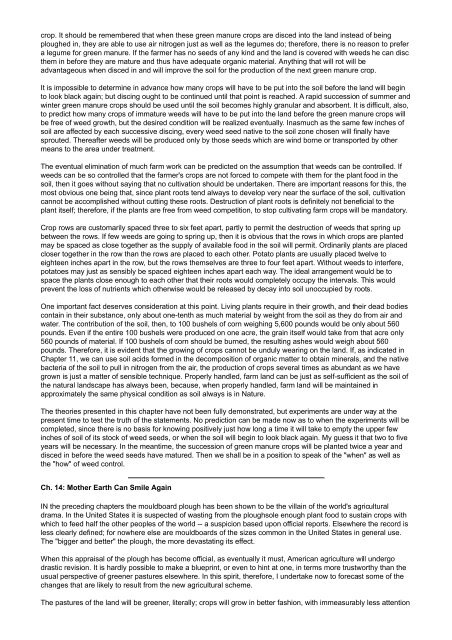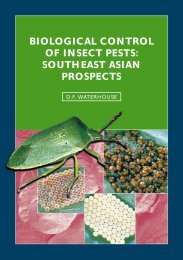Ploughman's Folly Ploughman's Folly - EcoPort
Ploughman's Folly Ploughman's Folly - EcoPort
Ploughman's Folly Ploughman's Folly - EcoPort
Create successful ePaper yourself
Turn your PDF publications into a flip-book with our unique Google optimized e-Paper software.
crop. It should be remembered that when these green manure crops are disced into the land instead of being<br />
ploughed in, they are able to use air nitrogen just as well as the legumes do; therefore, there is no reason to prefer<br />
a legume for green manure. If the farmer has no seeds of any kind and the land is covered with weeds he can disc<br />
them in before they are mature and thus have adequate organic material. Anything that will rot will be<br />
advantageous when disced in and will improve the soil for the production of the next green manure crop.<br />
It is impossible to determine in advance how many crops will have to be put into the soil before the land will begin<br />
to look black again; but discing ought to be continued until that point is reached. A rapid succession of summer and<br />
winter green manure crops should be used until the soil becomes highly granular and absorbent. It is difficult, also,<br />
to predict how many crops of immature weeds will have to be put into the land before the green manure crops will<br />
be free of weed growth, but the desired condition will be realized eventually. Inasmuch as the same few inches of<br />
soil are affected by each successive discing, every weed seed native to the soil zone chosen will finally have<br />
sprouted. Thereafter weeds will be produced only by those seeds which are wind borne or transported by other<br />
means to the area under treatment.<br />
The eventual elimination of much farm work can be predicted on the assumption that weeds can be controlled. If<br />
weeds can be so controlled that the farmer's crops are not forced to compete with them for the plant food in the<br />
soil, then it goes without saying that no cultivation should be undertaken. There are important reasons for this, the<br />
most obvious one being that, since plant roots tend always to develop very near the surface of the soil, cultivation<br />
cannot be accomplished without cutting these roots. Destruction of plant roots is definitely not beneficial to the<br />
plant itself; therefore, if the plants are free from weed competition, to stop cultivating farm crops will be mandatory.<br />
Crop rows are customarily spaced three to six feet apart, partly to permit the destruction of weeds that spring up<br />
between the rows. If few weeds are going to spring up, then it is obvious that the rows in which crops are planted<br />
may be spaced as close together as the supply of available food in the soil will permit. Ordinarily plants are placed<br />
closer together in the row than the rows are placed to each other. Potato plants are usually placed twelve to<br />
eighteen inches apart in the row, but the rows themselves are three to four feet apart. Without weeds to interfere,<br />
potatoes may just as sensibly be spaced eighteen inches apart each way. The ideal arrangement would be to<br />
space the plants close enough to each other that their roots would completely occupy the intervals. This would<br />
prevent the loss of nutrients which otherwise would be released by decay into soil unoccupied by roots.<br />
One important fact deserves consideration at this point. Living plants require in their growth, and their dead bodies<br />
contain in their substance, only about one-tenth as much material by weight from the soil as they do from air and<br />
water. The contribution of the soil, then, to 100 bushels of corn weighing 5,600 pounds would be only about 560<br />
pounds. Even if the entire 100 bushels were produced on one acre, the grain itself would take from that acre only<br />
560 pounds of material. If 100 bushels of corn should be burned, the resulting ashes would weigh about 560<br />
pounds. Therefore, it is evident that the growing of crops cannot be unduly wearing on the land. If, as indicated in<br />
Chapter 11, we can use soil acids formed in the decomposition of organic matter to obtain minerals, and the native<br />
bacteria of the soil to pull in nitrogen from the air, the production of crops several times as abundant as we have<br />
grown is just a matter of sensible technique. Properly handled, farm land can be just as self-sufficient as the soil of<br />
the natural landscape has always been, because, when properly handled, farm land will be maintained in<br />
approximately the same physical condition as soil always is in Nature.<br />
The theories presented in this chapter have not been fully demonstrated, but experiments are under way at the<br />
present time to test the truth of the statements. No prediction can be made now as to when the experiments will be<br />
completed, since there is no basis for knowing positively just how long a time it will take to empty the upper few<br />
inches of soil of its stock of weed seeds, or when the soil will begin to look black again. My guess it that two to five<br />
years will be necessary. In the meantime, the succession of green manure crops will be planted twice a year and<br />
disced in before the weed seeds have matured. Then we shall be in a position to speak of the "when" as well as<br />
the "how" of weed control.<br />
Ch. 14: Mother Earth Can Smile Again<br />
IN the preceding chapters the mouldboard plough has been shown to be the villain of the world's agricultural<br />
drama. In the United States it is suspected of wasting from the ploughsole enough plant food to sustain crops with<br />
which to feed half the other peoples of the world -- a suspicion based upon official reports. Elsewhere the record is<br />
less clearly defined; for nowhere else are mouldboards of the sizes common in the United States in general use.<br />
The "bigger and better" the plough, the more devastating its effect.<br />
When this appraisal of the plough has become official, as eventually it must, American agriculture will undergo<br />
drastic revision. It is hardly possible to make a blueprint, or even to hint at one, in terms more trustworthy than the<br />
usual perspective of greener pastures elsewhere. In this spirit, therefore, I undertake now to forecast some of the<br />
changes that are likely to result from the new agricultural scheme.<br />
The pastures of the land will be greener, literally; crops will grow in better fashion, with immeasurably less attention






